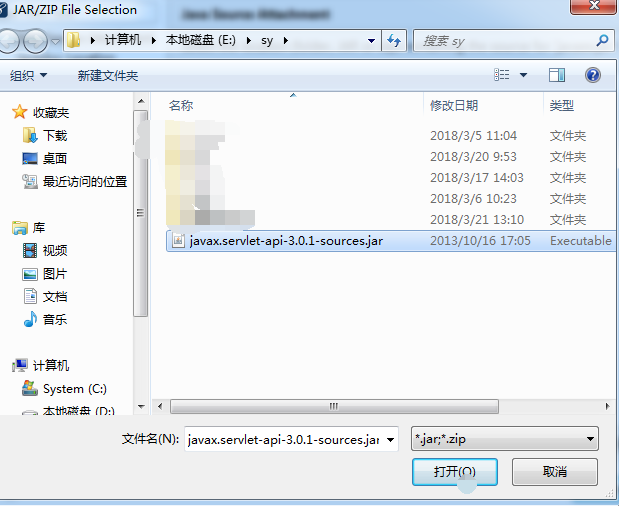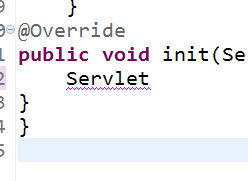servlet源码查看
1,下载源码,点击此处可下载
2,创建web项目

我这里以jdbc这个web项目为例讲解

在javaee libraries中有个javaee.jar包,选中它-->右击--》Properties

找到你下载的jar包

打开---apply 即可】
在任意一个.java文件中,编写servlet,按住ctrl键,鼠标单击类(或接口)名,即可查看源码

下面是servlet完整源码
/*
* DO NOT ALTER OR REMOVE COPYRIGHT NOTICES OR THIS HEADER.
*
* Copyright (c) 1997-2010 Oracle and/or its affiliates. All rights reserved.
*
* The contents of this file are subject to the terms of either the GNU
* General Public License Version 2 only ("GPL") or the Common Development
* and Distribution License("CDDL") (collectively, the "License"). You
* may not use this file except in compliance with the License. You can
* obtain a copy of the License at
* https://glassfish.dev.java.net/public/CDDL+GPL_1_1.html
* or packager/legal/LICENSE.txt. See the License for the specific
* language governing permissions and limitations under the License.
*
* When distributing the software, include this License Header Notice in each
* file and include the License file at packager/legal/LICENSE.txt.
*
* GPL Classpath Exception:
* Oracle designates this particular file as subject to the "Classpath"
* exception as provided by Oracle in the GPL Version 2 section of the License
* file that accompanied this code.
*
* Modifications:
* If applicable, add the following below the License Header, with the fields
* enclosed by brackets [] replaced by your own identifying information:
* "Portions Copyright [year] [name of copyright owner]"
*
* Contributor(s):
* If you wish your version of this file to be governed by only the CDDL or
* only the GPL Version 2, indicate your decision by adding "[Contributor]
* elects to include this software in this distribution under the [CDDL or GPL
* Version 2] license." If you don't indicate a single choice of license, a
* recipient has the option to distribute your version of this file under
* either the CDDL, the GPL Version 2 or to extend the choice of license to
* its licensees as provided above. However, if you add GPL Version 2 code
* and therefore, elected the GPL Version 2 license, then the option applies
* only if the new code is made subject to such option by the copyright
* holder.
*
*
* This file incorporates work covered by the following copyright and
* permission notice:
*
* Copyright 2004 The Apache Software Foundation
*
* Licensed under the Apache License, Version 2.0 (the "License");
* you may not use this file except in compliance with the License.
* You may obtain a copy of the License at
*
* http://www.apache.org/licenses/LICENSE-2.0
*
* Unless required by applicable law or agreed to in writing, software
* distributed under the License is distributed on an "AS IS" BASIS,
* WITHOUT WARRANTIES OR CONDITIONS OF ANY KIND, either express or implied.
* See the License for the specific language governing permissions and
* limitations under the License.
*/ package javax.servlet; import java.io.IOException; /**
* Defines methods that all servlets must implement.
*
* <p>A servlet is a small Java program that runs within a Web server.
* Servlets receive and respond to requests from Web clients,
* usually across HTTP, the HyperText Transfer Protocol.
*
* <p>To implement this interface, you can write a generic servlet
* that extends
* <code>javax.servlet.GenericServlet</code> or an HTTP servlet that
* extends <code>javax.servlet.http.HttpServlet</code>.
*
* <p>This interface defines methods to initialize a servlet,
* to service requests, and to remove a servlet from the server.
* These are known as life-cycle methods and are called in the
* following sequence:
* <ol>
* <li>The servlet is constructed, then initialized with the <code>init</code> method.
* <li>Any calls from clients to the <code>service</code> method are handled.
* <li>The servlet is taken out of service, then destroyed with the
* <code>destroy</code> method, then garbage collected and finalized.
* </ol>
*
* <p>In addition to the life-cycle methods, this interface
* provides the <code>getServletConfig</code> method, which the servlet
* can use to get any startup information, and the <code>getServletInfo</code>
* method, which allows the servlet to return basic information about itself,
* such as author, version, and copyright.
*
* @author Various
*
* @see GenericServlet
* @see javax.servlet.http.HttpServlet
*
*/ public interface Servlet { /**
* Called by the servlet container to indicate to a servlet that the
* servlet is being placed into service.
*
* <p>The servlet container calls the <code>init</code>
* method exactly once after instantiating the servlet.
* The <code>init</code> method must complete successfully
* before the servlet can receive any requests.
*
* <p>The servlet container cannot place the servlet into service
* if the <code>init</code> method
* <ol>
* <li>Throws a <code>ServletException</code>
* <li>Does not return within a time period defined by the Web server
* </ol>
*
*
* @param config a <code>ServletConfig</code> object
* containing the servlet's
* configuration and initialization parameters
*
* @exception ServletException if an exception has occurred that
* interferes with the servlet's normal
* operation
*
* @see UnavailableException
* @see #getServletConfig
*
*/ public void init(ServletConfig config) throws ServletException; /**
*
* Returns a {@link ServletConfig} object, which contains
* initialization and startup parameters for this servlet.
* The <code>ServletConfig</code> object returned is the one
* passed to the <code>init</code> method.
*
* <p>Implementations of this interface are responsible for storing the
* <code>ServletConfig</code> object so that this
* method can return it. The {@link GenericServlet}
* class, which implements this interface, already does this.
*
* @return the <code>ServletConfig</code> object
* that initializes this servlet
*
* @see #init
*
*/ public ServletConfig getServletConfig(); /**
* Called by the servlet container to allow the servlet to respond to
* a request.
*
* <p>This method is only called after the servlet's <code>init()</code>
* method has completed successfully.
*
* <p> The status code of the response always should be set for a servlet
* that throws or sends an error.
*
*
* <p>Servlets typically run inside multithreaded servlet containers
* that can handle multiple requests concurrently. Developers must
* be aware to synchronize access to any shared resources such as files,
* network connections, and as well as the servlet's class and instance
* variables.
* More information on multithreaded programming in Java is available in
* <a href="http://java.sun.com/Series/Tutorial/java/threads/multithreaded.html">
* the Java tutorial on multi-threaded programming</a>.
*
*
* @param req the <code>ServletRequest</code> object that contains
* the client's request
*
* @param res the <code>ServletResponse</code> object that contains
* the servlet's response
*
* @exception ServletException if an exception occurs that interferes
* with the servlet's normal operation
*
* @exception IOException if an input or output exception occurs
*
*/ public void service(ServletRequest req, ServletResponse res)
throws ServletException, IOException; /**
* Returns information about the servlet, such
* as author, version, and copyright.
*
* <p>The string that this method returns should
* be plain text and not markup of any kind (such as HTML, XML,
* etc.).
*
* @return a <code>String</code> containing servlet information
*
*/ public String getServletInfo(); /**
*
* Called by the servlet container to indicate to a servlet that the
* servlet is being taken out of service. This method is
* only called once all threads within the servlet's
* <code>service</code> method have exited or after a timeout
* period has passed. After the servlet container calls this
* method, it will not call the <code>service</code> method again
* on this servlet.
*
* <p>This method gives the servlet an opportunity
* to clean up any resources that are being held (for example, memory,
* file handles, threads) and make sure that any persistent state is
* synchronized with the servlet's current state in memory.
*
*/ public void destroy();
}
servlet源码查看的更多相关文章
- Eclipse查看Servlet源码
Eclipse查看Servlet源码 @(Java) 1.servlet-api 和 javax.servlet-api的区别 在正式查看Servlet源码前,我们首先要分清楚上述两个jar包的区别. ...
- android 网络_网络源码查看器
xml设计 <?xml version="1.0"?> -<LinearLayout tools:context=".MainActivity" ...
- Servlet源码初探
年底,公司的事情告一段落,就来捣鼓一下这个Servlet源码,为下一步的spingmvc源码初探做准备 1.Servlet接口 public interface Servlet { void init ...
- qml源码查看
已5.4为例说明: QtQuick源码查看: 地址:Qt\Qt5.4.1\5.4\Src\qtdeclarative\src\quick\items Qt control源码查看: 地址:\Qt\Qt ...
- httpServlet,GenericServlet,Servlet源码分析
httpServlet源码: /* * Licensed to the Apache Software Foundation (ASF) under one or more * contribut ...
- idea导入jdk源码查看(xjl456852原创)
idea添加了jdk环境后,却无法查看jdk源码,只能通过idea自带的反编译查看,看起来有些不爽. 下面来说一下如何设置,导入jdk源码,查看时通过源码查看jdk. 1.点击菜单 File -> ...
- Android 网络图片查看器与网页源码查看器
在AndroidManifest.xml里面先添加访问网络的权限: <uses-permission android:name="android.permission.INTERNET ...
- IDE:Eclipse查看Servlet源码
一.源码下载 1.打开tomcat官网:http://tomcat.apache.org/ , 点击右侧下载菜单(以tomcat-7为例)进入下载页面:http://tomcat.apache. ...
- springboot 2.1.3.RELEASE添加filter,servlet源码学习
Servlet规范中,通过ServeltContext来注册Filter.Servlet,这里分析Filter,Servlet是相同逻辑 springboot2.0中,我们通过 FilterRegis ...
随机推荐
- “帮你APP”团队冲刺2
1.整个项目预期的任务量 (任务量 = 所有工作的预期时间)和 目前已经花的时间 (所有记录的 ‘已经花费的时间’),还剩余的时间(所有工作的 ‘剩余时间’) : 所有工作的预期时间:88h 目前已经 ...
- 关于前后端日期处理 开发注意事项 jquery.tmpl()函数的使用
1当后端将日期传到前段的时候 我们通常会需要将日期转为制定格式 除了平常我们使用的前段插件将日期转好 spring @datetimeFormat 注解 这些形式外 我们还可以在实体里通过get方法进 ...
- MySQL基础4-SQL简单查询(单表)
1.SELECT语句 2.运算符的优先级 利用Navicat中的查询方法: 栗子1:查询所有货品信息 栗子2:查询所有货品的id,productName,salePrice 当查询错误的时候出现的界面 ...
- Backpropagation Through Time (BPTT) 梯度消失与梯度爆炸
Backpropagation Through Time (BPTT) 梯度消失与梯度爆炸 下面的图显示的是RNN的结果以及数据前向流动方向 假设有 \[ \begin{split} h_t & ...
- 【转】Unity3D 射线Ray实现点击拾取
游戏中经常会有鼠标移动到某个对象上来拾取它的功能,我们可以用Unity3D中的射线Ray实现这一效果.原理是在我们鼠标的位置,从屏幕射出一条射向世界空间的射线,当这条射线碰撞到我们需要拾取的对象时,我 ...
- 【bzoj4386】[POI2015]Wycieczki 矩阵乘法
题目描述 给定一张n个点m条边的带权有向图,每条边的边权只可能是1,2,3中的一种.将所有可能的路径按路径长度排序,请输出第k小的路径的长度,注意路径不一定是简单路径,即可以重复走同一个点. 输入 第 ...
- HDU 5322 Hope ——NTT 分治 递推
发现可以推出递推式.(并不会) 然后化简一下,稍有常识的人都能看出这是一个NTT+分治的情况. 然而还有更巧妙的方法,直接化简一下递推就可以了. 太过巧妙,此处不表,建议大家找到那篇博客. 自行抄写 ...
- 【BZOJ 5047 空间传送装置】
Time Limit: 20 Sec Memory Limit: 256 MBSubmit: 282 Solved: 121[Submit][Status][Discuss] Descriptio ...
- 笔记:CS231n+assignment1(作业一)
CS231n的课后作业非常的好,这里记录一下自己对作业一些笔记. 一.第一个是KNN的代码,这里的trick是计算距离的三种方法,核心的话还是python和machine learning中非常实用的 ...
- 【bzoj4699】树上的最短路(树剖+线段树优化建图)
题意 给你一棵 $n$ 个点 $n-1$ 条边的树,每条边有一个通过时间.此外有 $m$ 个传送条件 $(x_1,y_1,x_2,y_2,c)$,表示从 $x_1$ 到 $x_2$ 的简单路径上的点可 ...
